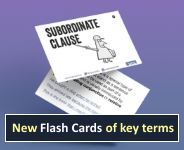Clause patterns in online recipes
This activity looks at different clause patterns (statement; question; command; exclamation) in an online recipe. Students are asked to think about why different clause patterns are used, and what kind of role they play in creating the meaning of the text.
Goals
- Consolidate understanding of different clause patterns.
- Analyse the use of clause patterns in a real text.
- Create a text using different clause patterns.
Lesson Plan
This lesson might come after you have taught your students about the four clause patterns in English: statement, question, command and exclamation. You might want to revisit these before starting this lesson, by checking out some of the resources on Englicious (for example, here and here).
Begin by asking your students what kind of language features they might expect to see in a recipe, and why those features might be there. Their answers might include the following ideas:
- Words (especially nouns) related to kitchen and cooking equipment such as saucepan, bowl, whisk, etc.
- Verbs related to cooking and food preparation, such as heat, stir, chop, etc.
- Adverbs of time and manner to show how these verbs are done, such as slowly, carefully, gradually.
- The use of images to show the desired end product.
- Statements to describe what the food should ideally look like, e.g. A simple pasta and tomato dish - delicious, filling and cheap.
- Commands to instruct the reader what to do, e.g. Heat the oil in a medium pan and fry the onion for 5 mins.
Next, give students a copy of the handout (found at the bottom of this page), which is taken from a BBC Good Food recipe (also available here). Read it through with them and check for understanding.
The next task is to look at the grammar of the text, focusing specifically on clause patterns. To do this, ask students to:
- Highlight each sentence according to whether it is a statement, question, command or exclamation. A good way to do this is by using four different colours, because this gives you a good idea of the clause patterns across the whole text.
- What do you notice? Are there parts of the text where a certain clause pattern is used more than others? If so, why do you think this might be?
As an extension task, you could ask students to look at the other language features discussed at the beginning of the lesson.
The final activity in this lesson involves creating a recipe. Students should:
- Think carefully about their grammatical choices, using what they now know about the kind of language used in real, published recipes.
- Design the recipe so that it follows a logical order.
- Invent some 'user comments' - these could be good or bad reviews!
As an extension task, you could ask students to write a few sentences explaining what they have done with language, and write about some of the choices they made.
Welcome!

Englicious is totally free for everyone to use!
But in exchange, we ask that you register for an account on our site.
If you’ve already registered, you can log in straight away.
Since this is your first visit today, you can see this page by clicking the button below.
- Printer-friendly version
- Log in to view or leave comments

